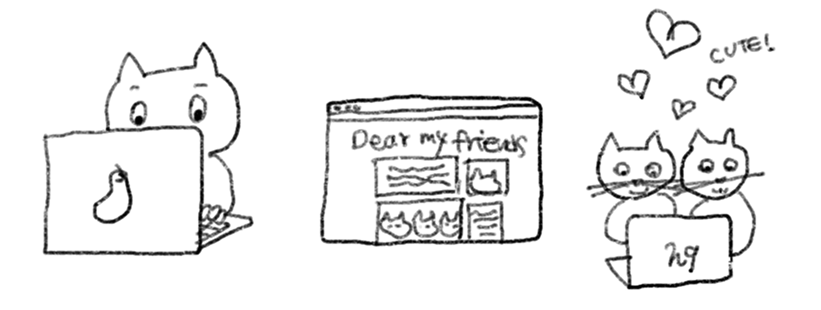

The prologue introduces audiences what the Podcast show Safety Nets: Let Me Zine is about :)


Listen to the Podcast!
Follow the show by pasting the
following link into your favorite podcast app:
https://let-me-zine.htmlzine.club/podcast/htmlzineclub-let-me-zine.xml
💘 How to subscribe:
Or just listen online at: https://let-me-zine.htmlzine.club/podcast, clicking each episode.
(Prologue is spoken by the artist Nami Kim.)
Safety Nets: Let Me Zine project is funded by Talent Development grant from Stimuleringsfond, Creative Industries Fund NL.
How can we make a safe space on the web? What are hands-on digital activities to manifest free self-expression? And how can these methods preserve safety online along with our identities?
… [Intro music]
Welcome to the Podcast Safety Nets: Let Me Zine. Hello, my name is Nami and I'm an artist based in Rotterdam and a system admin of HTML Zine Club. In this prologue, I'll introduce my current project and this Podcast, which is as an essential part of it.
So I can overview what the project examines as follows:
I can imagine there are unfamiliar terms like self-hosting server, hand-made web, HTML Zine, etc for some of you. Hopefully these concepts will be unpacked to help you understand context.
Do you know how the website's visuality is composed of? Basically the structure of a website is made with HTML. It's an abbreviation of Hypertext Markup Language. It uses "markup" to define the content and structure of web pages, such as headings, paragraphs, and links, images, which web browsers then display. It's eventually a document that the web browser can recognise. And CSS, which is Cascading Style Sheet, a good friend of HTML. It stylises HTML elements, like in which sizes and in which fonts your heading and paragraph will look like? How big is your image? How is the layout? etc.
Fascinated by HTML & CSS, which are one of the most basic web coding languages. I've been hosting workshops to friendly skill-share about how to make one's own website.
Then last year, I created a HTML Zine Club server where people can host their own personal webpages which I call HTML Zine, as well as learn the basic web coding techniques. As an admin of the web community, I've been manifesting that the hand-made web is an emancipatory medium, out of existing social network platforms with limited autonomy. Hereby I mean the hand-made web by webpages built by individuals embracing personal and crafted manner of making. By writing lines of codes on your own, you also get to understand how the surfaces of web interface is visualised. I just said I call these webpages HTML Zine, as it's a form of again personal and experimental digital publication made in a “hands-on” manner.
Plus, it's circulated around a small group of readers than big. Hosting many workshops and education courses in various places, I've been always amazed by what people make. Bullshit work experiences, Free poems, Love letters, Memories with their friends, A dedicative essay for grandparents, Girlhoods, Traumatic anecdote and how it is being unlearned, Collections of what they love, Fictional spaces, Queer identity, and so on, and so on… These are very experimentally unraveled on the web canvas.
However, I've been facing concerns shown by some users. Which is that they are not sure if they want to host their webzines online, as it contains quite innermost/personal materials. Indeed on the webzine, people tend to talk about stories they wouldn't really post on Instagram or Facebook. Also the ways how they express are sometimes quite bold. And they don't want their works to be randomly crawled and scrapped by AI bots. It's also worrying that your work might get an anonymous harassment.
Since facing this matter, I haven't felt comfortable to run the server. In fact, it's an urgent topic to cover, before encouraging people to host their webzines on HTML Zine Club. The Internet has developed into something different as intended and desired. AI crawlers, Dark web design patterns, users' data sold by the IT giants… Feeling an urgency to reconsider the direction of the personalised web, I've contrived this project. My research focuses on web security protocols today for users, as well as for artistic web makers and cultural server operators.
In addition it will examine how the self-expression often containing our identities have been evolving around the web history. This Podcast has the same title with my project, Safety Nets: Let Me Zine. I aim to publish 8 episodes from now on every month.
Every episode has one or two guests. Those are artists, designers, researchers and cultural server administrators who are exploring autonomous digital practices. I'm very excited to learn from them, as well as to share my exploration with you. The first episode will be released by the end of October.
I hope you enjoy the show and… I'd be grateful to have your feedback each episode! There would be different opinions on my project. Maybe certain practices are too romanticised. or some technical knowledge shared on the show is debatable… Pls let me know what you think!
[Outro music] Well... that's it. It's an awkward ending… I'll meet you in the first episode with lovely guests! Till then, take care all! Ciao!
Safety Nets: Let Me Zine project is funded by Talent Development grant from Stimuleringsfond, Creative Industries Fund NL.